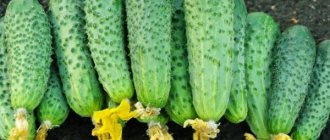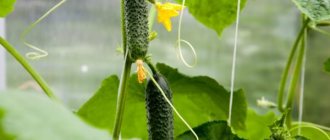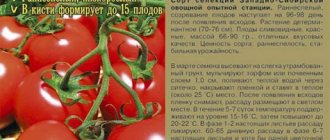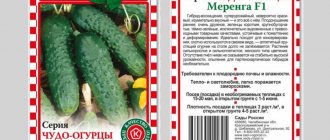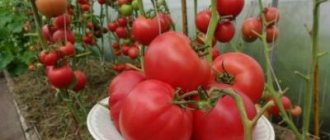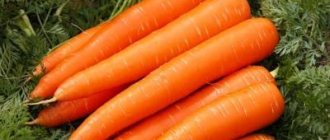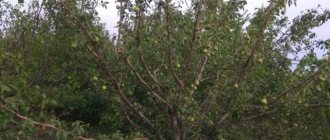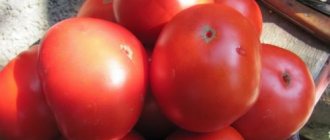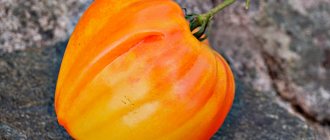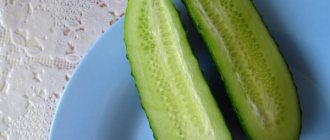It’s worth starting the description of the Cheerful Dwarfs f1 cucumber variety with the fact that it is an ultra-early cucumber and has a record ripening time of 38-40 days. It was officially included in the Register and went on mass sale in 2013. The cucumber is versatile - it grows well in open ground, on the balcony, and in the greenhouse. Despite its early ripening, the variety has excellent taste. Cheerful gnomes can be added to salads, main courses, and canned.
Description of cucumbers Cheerful gnomes
According to the official description, Merry gnomes f1 are well suited for most domestic climatic zones; they tolerate frosts and even droughts well due to their well-developed and strong root system. This cucumber is parthenocarpic and does not require insect pollination.
The yield of the variety is quite high for early vegetables - 18-20 kg/m². The immunity of the hybrid is also at the level - in the open ground, Cheerful gnomes practically do not suffer from common infections.
The external description of the variety emphasizes one distinctive detail - the greens ripen on the bush in clusters, 4-5 pieces each. The bush itself grows in one stem, reaching a height of 1.5 m, which makes it possible to cultivate such a cucumber even in an apartment. The leaves on it are small, oval, slightly wavy, dark green in color. The flowers are small, bright yellow.
Zelentsy Cheerful gnomes f1 are small in size - 9-10 cm in length, weight - up to 90 g. Due to their miniature size, they are perfect for preservation. The cucumber is almost uniform, rich green in color with barely noticeable light stripes. The taste of vegetables of this variety is fresh, sweetish, juicy and crispy, even after heat treatment.
Description
The hybrid is characterized by the fact that the flowers are formed in bouquets, and each flower has its own ovary. The fruits ripen in bunches and together, and pollination is not required for their appearance. The yield level will be the same both in the garden and in greenhouse conditions. Due to the small height of the bushes, they can be grown on the balcony, but fruiting at home will be less active.
Cucumber Merry gnomes are:
- semi-standard type;
- lashes up to 1.2 m long with a limited growth point;
- a bush with a small number of side shoots, which are not a way to unload the main stem;
- plants that need to be formed into one central shoot;
- a crop from which stepsons need to be removed;
- a variety grown using the trellis method so that the plant does not sag during fruiting.
There are features:
- The trunk is light green in color without pubescence, with an uneven surface and a hard fibrous structure.
- The foliage is not large in size. The degree of foliage is average, and the leaves themselves are opposite, heart-shaped. There are large teeth along the edges. The plate is pointed upward, and its surface has a slight roughness and short pile. The color is deep green on the front side and light green on the back.
- The rhizome of the variety is fibrous, located superficially with large branching and a small root circle.
Note!
The flowers have a lemon tint and are predominantly female. According to statistics, each of them turns out to be fertile, without barren flowers.
The hybrid was developed through cross-pollination of several varieties; it does not contain genetically modified elements, and therefore can be consumed by adults and children without restrictions.
Pros and cons of the variety
Cheerful gnomes f1, despite the relative youth of the variety, have managed to earn popularity among summer residents and professional vegetable growers who grow herbs for sale. This cucumber is resistant to temperature changes, does not require complex care and boasts an unusual, bright taste.
pros
The new generation variety has many advantages. Judging by the description, it is precocious, but this quality practically does not affect its taste and beneficial properties. Among the most important positive aspects of the Merry Dwarves:
- productivity - with generous watering and high-quality fertilizing, you can get up to 20 kg/m² of excellent, marketable vegetables;
- excellent taste and aroma - cucumber has the highest taste qualities and does not become bitter even when overgrown;
- resistance – the Veselye Dwarfs variety is able to withstand frosts up to 7° and soil overheating slightly above 20° without loss of quality;
- high immunity - the greenhouse variety does not suffer from parasites, and the ground variety is not afraid of viruses and bacteria.
The side shoots of Merry Dwarfs f1 develop weakly; the cucumber does not require complex manipulations when forming a bush.
Minuses
No significant deficiencies were found in the variety. Some vegetable growers note in the description the high dependence of yield on the quality of fertilizing and watering. In general, the main disadvantages of Jolly Gnomes are as follows:
- low germination - unlike such hybrids as Boy with a Thumb, the seeds of the main variety germinate only 75-85%;
- decrease in yield in apartment conditions - those who are going to cultivate cucumber on the balcony should take into account that in this case its yield will drop by 1.5 times;
- greenhouse vegetables sometimes suffer from anthracnose, while ground vegetables are susceptible to whitefly attacks.
Cheerful gnomes f1 require a lot of water and suffer greatly from lack of watering.
Cucumber “All in a bunch” F1 photo and review
- Juicy
- Moderately sweet
- Crisp
- Melts in your mouth
- Thin peel, invisible seeds
- Good in salads and preserves
Cucumber “All in a bunch” F1
Photo of the packaging, click on the photo to enlarge, it will open in a new tab:
Landing Features
The cucumber in question is shade-tolerant, but still prefers places exposed to the sun. For Merry Gnomes, preliminary germination is recommended. Due to its short ripening period, cucumber is capable of producing several harvests per season.
Landing dates
This variety feels best in a tall, spacious greenhouse. The earliest date for planting Jolly Dwarf seeds for seedlings is the last days of March. Optimal for any type of cultivation is to plant seeds for cultivation on the 20th of April. In this case, the sprouted cucumber can be added to the soil as early as May 10-20. The main condition is that the soil has a temperature of at least 14° so that the seedlings do not freeze.
Site preparation
Cheerful gnomes f1 feel best in flat areas, sheltered from the winds, located on the southeast side. In the fall, the soil under the cucumber is dug deeply, removing all the sprouts of weeds and other debris. After this, according to the description, the soil with high acidity is fed with dolomite flour, then standard fertilizers for the variety are applied - saltpeter and manure.
Immediately before planting the Jolly Dwarfs, the soil is loosened again and phosphorus fertilizers are applied.
Planting seeds
Cucumber tolerates seedling cultivation best. A nutritious soil mixture is poured into separate small cups or pots with holes, moistened well and 2-3 Cheerful Dwarf seeds are added to each to a depth of 2-2.5 cm. Then the plantings are placed in a place with a temperature of 21°-22°.
Water the seedlings of the variety through a spray bottle with well-heated water. Before planting the cucumber in the beds, leave one sprout at a time in the containers.
Planting seedlings
The seedlings of the variety are transferred to the ground 25-28 days after planting. By this moment, the cheerful gnomes should have 3-4 full-fledged leaves. The sprouts are transported carefully - their roots are very fragile and break easily.
4-5 plants per 1 m² are transplanted into open ground, and no more than 3 into a greenhouse. The sprouts of Cheerful Gnomes f1 are deepened by 7-10 cm. Immediately after planting, each cucumber must be covered with earth so that it is better strengthened and watered abundantly.
Planting scheme
Despite its relatively small size, the variety needs space - crowded planting leads to diseases. The ideal distance between the plants of the Jolly Dwarfs is 30-35 cm. At the same time, the cucumber requires a row spacing of 65 to 70 cm.
If necessary, as the plantings grow, it is worth thinning them out so that they do not interfere with each other - this is especially important for greenhouse vegetables.
Hybrid characteristics
The Merry Dwarfs cucumber belongs to the type of parthenocarpic varieties that do not require pollination by insects. The bush and root system are powerful, grown in one stem. The excess stepsons are cut off so that the bush is formed correctly. In this case, 3–5 fruits are set in the axil. The variety is early ripening - only 38–40 days pass from the first shoots to harvest when grown in greenhouses or in beds. When grown at home, the yield will be smaller. When grown, the bushes are resistant to common diseases.
Care
Gardeners call Cheerful Gnomes a variety that is not too demanding to care for. The main thing that the hybrid requires for successful ripening, according to the description, is regular watering, periodic feeding, and timely weeding. A cucumber can be attacked by parasites, so cleanliness on the site and regular inspection of the plantings of the variety are of particular importance for the harvest.
Watering
Water the cucumber every 3-4 days as the soil dries. Cheerful gnomes f1 prefer the drip method of watering - the water should go to the root so as not to cause burns to the foliage. In normal weather, the variety is watered in the evening, in extreme heat - in the early morning.
The water temperature is preferably room temperature, or 2°-3° warmer. On days of severe drought, water the cucumber every other day.
Garter and bush formation
The variety is usually formed into one, central stem. In this case, all side shoots must be blinded at the level of 2-3 leaves. To prevent the cucumber from wasting its strength, the lower leaves at this level are also removed.
In order for the Merry Gnomes to grow comfortably, they are tied up early and attached to trellises as high as possible - first of all, in a greenhouse, where the cucumber can become infected with rot. There is no need to pinch the top.
Top dressing
Early varieties need abundant feeding. The first time Merry Dwarves fertilize, based on the description, 2 weeks after planting. Use a solution of manure or chicken droppings. Then regular feeding is carried out every 10 days.
During the period of active growth, the cucumber is fed with nitrogen fertilizers, and at the time of ovary formation - with potassium-phosphorus and organic fertilizers.
Hilling
Hilling up the cucumber is necessary so that it takes root better in the soil and does not freeze during night frosts. The first time the Merry Dwarfs are sprinkled with earth immediately after transplanting into the ground - they are covered halfway up their height. All subsequent hillings are carried out as described, if necessary.
Grown plants of the variety are sprinkled with soil to the level of the lower leaves. Do not forget about loosening - the soil under the cucumber must be loosened as a hard crust forms.
Cucumber Merry gnomes F1: reviews, photos, yield, growing rules
For those who like to grow original cucumber varieties, there are varieties on the market with bouquet fruit growth.
Cucumber Cheerful gnomes f1 looks on the stem like a bunch of bananas, original and beautiful. In addition, these bushes produce a bountiful harvest under any growing conditions. Let's look at the characteristics of the variety and find out how to grow bushes and get a bountiful harvest. The Merry Dwarfs cucumber belongs to the type of parthenocarpic varieties that do not require pollination by insects. The bush and root system are powerful, grown in one stem. The excess stepsons are cut off so that the bush is formed correctly.
In this case, 3–5 fruits are set in the axil. The variety is early ripening - only 38–40 days pass from the first shoots to harvest when grown in greenhouses or in beds. When grown at home, the yield will be smaller.
When grown, the bushes are resistant to popular diseases.
Description of fruits
Cucumbers are small in size - they reach 9 centimeters in length and weigh an average of 80 grams. The fruit is dark green on the stem side and light green on the flower side; there are also yellow stripes on this side that reach the middle of the fruit. Heavily lumpy, with white spines on the surface. The skin is thin, the flesh is juicy and crispy.
Cucumbers do not overgrow if they are not picked on time. The taste of the fruit is distinctly cucumber-like, sweet, and with poor watering there is no bitterness. Suitable for all types of preservation and fresh consumption.
The fruits must be collected in a timely manner - although they do not outgrow, the bush dries out when mature fruits remain on the bush for a long time.
The variety tolerates transportation well and does not deteriorate during long-term storage.
Judging by the reviews, gardeners highlight the following positive qualities in this variety:
- early ripeness and high yield;
- possibility of growing in open and closed ground;
- disease resistance;
- high quality of fruits and duration of fruiting;
- versatility in use and resistance to overgrowth;
- possibility of growing in production areas for sale.
The hybrid is grown in two ways:
- planting seeds in the ground;
- growing seedlings followed by transplanting into the ground.
When grown by seedlings, the seeds are planted in prepared soil at a distance of 20 by 30 centimeters, so as not to injure the root system during transplantation. Seeds are germinated before planting; to do this, you need to immerse the seeds in warm water for a day, and then keep them in a damp, but not wet, napkin.
In a few days sprouts will appear. Also popular is the method of planting seeds in peat pots, then the grown plants are planted in a permanent place of growth directly with the pot - the roots are not injured. Seeds are planted for seedlings in March - April.
The plants are planted with seeds in the greenhouse at the end of April, and in the beds in May. It is important that the air temperature outside does not drop to 15 degrees, otherwise the plants will freeze. When planting seeds in open beds, the soil is spilled with warm water and covered with film. After germination, the film is removed and cultivation continues in the open area.
To get a plentiful and high-quality harvest, cucumber vines need to be constantly looked after.
- Watering and loosening.
- Feeding, protection from diseases and pests.
- Weeding, gartering, pinching.
All these activities are part of the comprehensive care of cucumbers.
Since the variety is popular among amateur and professional gardeners, only positive reviews are left about it.
Gennady: “I’ve been growing funny gnomes for several years now and always get a high-quality harvest. Since the bushes grow in a greenhouse and in a garden bed, I alternate them every year.
I would like to note that the yield in a greenhouse and in open ground is almost the same. It’s just more convenient to grow in a greenhouse. I like cucumbers: they don’t overgrow, they’re all beautiful, they don’t curl, there’s no bitterness.
Since the bushes are powerful, I plant 3 bushes per square meter.”
I planted germinated seeds in open beds. All the seeds sprouted, only a few sprouts died in the garden bed.
I liked how cucumbers grow: in one bosom about five beautifully shaped fruits are formed, similar to bananas.”
Cucumber Merry gnomes is a hybrid of the latest generation. Created for cultivation in open ground (OG) and in protected areas.
During experimental cultivation, it was fully adapted to the weather conditions of the Central regions, Moscow region, European part, Siberia and the Urals.
The copyright holder of the variety is Agro - the only supplier of planting material on the seed market.
The cucumber variety Cheerful Gnomes is of the semi-standard type, grows up to 1.2 m in length. The end point of growth is limited; the cucumber variety produces few side shoots; they do not unload the main stem. The bush is formed with one central shoot, the stepsons are broken off. The Merry Dwarfs cucumber is grown using the trellis method; the plant requires fixation to a support during fruiting.
The cucumber of the Merry Dwarfs variety is characterized by the bouquet formation of flowers. The parthenocarpic hybrid forms an ovary on each flower, and the fruits ripen in bunches.
The crop does not require pollinators; the yield in greenhouses and greenhouses is the same. The plant is not tall, suitable for growing on balconies and in apartments on the windowsill.
At home, the yield is less, but two bushes of the variety are enough for a family of 4 people.
External description of the cucumber Merry gnomes F1:
- A plant with a limited growing point, the central trunk is light green with a gray tint. The pubescence is weak, the surface is uneven, the fibrous structure is hard. There are a small number of lateral shoots; they are thin, underdeveloped, and a shade darker than the main stem.
- The foliage is medium, the leaves are small, opposite, heart-shaped with large teeth along the edge, on short stalks. The leaf blade is pointed upward, the surface is rough, intensely pubescent with short hair. The color is green on the top of the leaf, the underside is lighter.
- The root system is fibrous, superficial, branched, the root circle is small.
- Lemon-colored flowers, collected in a leaf node, in the form of a bouquet of 3-6 pieces. The plant produces female flowers, ovaries are formed 100%, there are no barren flowers on the plant.
Attention! The hybrid Merry Dwarfs was bred by cross-pollination of varieties, does not contain genetically modified organisms (GMOs), and is allowed for consumption in unlimited quantities.
Cucumber variety Cheerful gnomes of bunch type. The fruits in each node are aligned, from the bottom to the top of the same weight and size. Zelentsy, when they reach biological ripeness, do not grow in length or width. During the aging process, they do not change color (do not turn yellow), retain their taste, acid and bitterness are completely absent. The only change is that the peel becomes tougher.
Characteristics of the fruits of the Merry Dwarfs variety:
- cucumber is cylindrical, slightly elongated, weighing 75-95 g, length 7-8 cm;
- the color is uneven, dark green near the stalk, becoming lighter at the top, with pronounced yellow stripes running from the point of attachment of the flower to the middle of the fruit. Greens at the stage of technical ripeness have a uniform green color;
- the surface is finely lumpy with a short white edge growing from the center of the irregularity;
- the peel is elastic, durable, thin, glossy, without a waxy coating. Resists minor mechanical stress well;
- the pulp has a dense consistency, light green, juicy, without voids, small seeds in small quantities;
- The taste of cucumber is sweet, with a pronounced aroma, without bitterness.
According to reviews from vegetable growers, cucumbers of the Merry Dwarfs variety, after harvesting, retain their taste and presentation for up to 3 weeks if stored in the refrigerator. The duration of storage without lowering the temperature is within 10 days.
The ability of the Merry Dwarfs cucumber to withstand transportation well and maintain its marketable appearance for a long time makes the variety suitable for commercial cultivation.
After hot processing, the cucumber retains its crunch and elasticity, no voids are formed in the pulp, and the color does not change.
The cucumber of the Cheerful Dwarfs variety does not require an excessive amount of sunlight for its growing season. In OG it grows in periodically shaded areas. The variety is frost-resistant, in the first phase of growth the plant tolerates temperatures down to 70 C, at 200 C it does not slow down its development, and can bear fruit if the temperature does not rise.
The drought tolerance of the Merry Dwarfs cucumber is excellent. The variety responds well to high temperatures, greens in a place exposed to the sun do not wither or bake, and the leaves do not turn yellow. The plant, like all representatives of the species, requires regular watering and moderate air humidity.
The advantages of the Cheerful Dwarfs cucumber variety include:
- frost resistance;
- undemanding to the amount of sunlight;
- high fruiting due to the bunch-shaped arrangement of flowers;
- yield does not depend on weather conditions and method of cultivation;
- the size of the fruit allows them to be preserved as a whole;
- gastronomic qualities are high;
- can be stored for a long time and transported safely;
- resistant to infection and pests.
The variety has no disadvantages. Like all representatives of the species, the Merry Dwarfs cucumber needs watering and staking to a trellis. The hybrid variety is prone to degeneration if cucumbers are bred with independently collected seeds from the mother bush.
Growing rules
Cheerful gnomes are propagated by planting seeds in the ground in a permanent place or by pre-grown seedlings. The seedling method is more used in regions with temperate climates, when cultivating cucumber varieties in greenhouses.
Sowing time
Cheerful gnomes cucumber seeds are planted for seedlings at the end of March. The plant grows quickly, in 25 days it forms 3 leaves - an indicator of planting in a permanent place. Seeds are sown in the ground when the soil has warmed up to at least 140 C, guided by the climatic characteristics of the region. Seeds are sown in the greenhouse in the 20th of April, and seedlings are planted in the second decade of May.
Like many other cultivated plants, it is advisable to grow Cheerful Gnomes by germinating seeds. Professional gardeners do it this way: they place the seeds in warm, settled water, and when they absorb moisture and swell, they leave them on a damp cloth for several days. The seeds quickly develop roots, so after 2 days almost all of them are completely ready for planting.
Diseases and parasites
Despite their strong immunity, Cheerful gnomes f1 need pre-planting treatment against viruses and timely treatment against parasites. Most often, a cucumber gets sick in a greenhouse, and the variety in the garden where the weeds are poorly weeded is eaten by pests.
Anthracnose
A fungal disease caused by high humidity at high temperatures. It is detected by the appearance of small wet yellowish marks on the leaves of the variety, which subsequently grow and rot.
As soon as the cucumber shows signs of anthracnose, the plantings of Cheerful Gnomes should be immediately treated with copper sulfate or Bordeaux mixture. After this, the entire greenhouse is sprayed with a solution of potassium permanganate.
Whitefly
This miniature white butterfly lays eggs on the inside of the leaves of the Jolly Gnomes. The hatched larvae not only devour the plant, but also carry bacteria. As soon as it is noticed that whitish midges are circling over the plantings, the area under the cucumber is immediately treated with garlic broth.
To combat multiplying insects, washing the leaves of the variety with a weak soap solution is effective.
Aphid
This widespread, incredibly voracious parasite is capable of destroying most of the variety's harvest. In order not to miss its appearance, you need to inspect the underside of the leaves of the Jolly Dwarfs every few days.
The most environmentally friendly way to control cucumbers is to spray them with a solution of wood ash or laundry soap. A weak decoction of celandine is also good. If there are a lot of aphids on the plantings, you will have to resort to insecticide treatment.
Cucumber Merry gnomes F1: reviews, photos, yield, growing rules
Sowing time
Ready seedlings are transferred to the greenhouse from mid-May, and to open ground in May-June. The bushes should have 4-6 true leaves, and the height of the stems should be 25-30 cm.
Plants need sunny beds on the south or east side of the garden. Shadow is allowed, but not much. The soil must be nutritious and loose, so it is dug up twice, adding fertilizers: first in the fall, then in early spring.
Cucumbers should not be placed in areas after other pumpkin crops, watermelons, melons, and zucchini.
The distance between the holes is 35 cm, between the rows - 45 cm. Supports are installed near the holes to tie up the lashes.
The bushes are fed two or three times a season. When the first flowers appear, add a solution of superphosphate (15 g per bucket of water), when the fruits set - organic fertilizers, for example, a solution of 1 liter of mullein in a bucket of water or a liter of chicken manure in 2 buckets of water.
Bushes are formed by removing all side shoots. Once a week or as needed, weed the weeds and carefully pierce the hard crust on the ground with a fork so that the roots receive oxygen.
Harvesting and storage
This early ripening cucumber begins to ripen in late June. A week before harvesting, you need to stop feeding. The greenery of the Cheerful Dwarfs f1 practically does not outgrow, however, in order to extend the fruiting period, it is better not to delay harvesting.
The variety is harvested every other day. The best time for this is evening, after 30-40 minutes. after watering. Cheerful gnomes are carefully cut with scissors or sharp pruning shears, trying not to damage the stalk.
Cucumber stores quite well. In the refrigerator, loosely wrapped in plastic, the harvest can remain fresh and fragrant for about 2-3 weeks. It is not recommended to wash greens after harvesting - this can significantly shorten its shelf life. The vegetable tolerates transportation well. Despite the thin skin, the variety does not crack or lose its marketable qualities even during long journeys, which makes it a good choice for cultivation for sale.
Characteristic
On the bushes of the Cheerful Gnome you can grow fruits that are: even and identical in weight and size. Once a cucumber reaches biological maturity, it will not grow in length or width. Over time, if the vegetables are not removed on time, they will begin to turn yellow, but at the same time retain their taste without bitterness. However, it is possible for the skin to become rough.
Zelentsy are characterized by:
May be interesting Varieties of bee-pollinated cucumbers: description with photos, cultivation features Cucumber “Vyatsky f1”: planting, cultivation and care Cucumber Garland f1: description and characteristics, reviews
- cylindrical shape, slightly elongated;
- weighing no more than 95 g;
- no more than 8 cm long;
- uneven shade, since near the stalk it can be darker, and where the vegetable is attached to the flower it is light with stripes;
- uniform color at the stage of technical ripeness;
- slight bumpiness on the surface;
- short pubescence;
- elastic, durable, but at the same time thin peel with a glossy finish, resistant to minor mechanical stress;
- dense pulp of a light shade, and there are no voids in it;
- small seeds in small quantities, not permissible for subsequent planting;
- sweetish taste;
- pronounced aroma;
- preservation of presentation for 3 weeks, provided that it is placed in the refrigerator on the bottom shelf;
- resistance to long-term transportation;
- lack of bitterness regardless of the stage of collection.
The variety is grown for sale or for fresh consumption.
Attention!
Cucumbers have an almost ideal shape and size, which allows them to be conveniently placed in a jar for preservation.
When hot processed, the greens will retain their crunch perfectly, and the flesh will remain just as elastic without voids.
